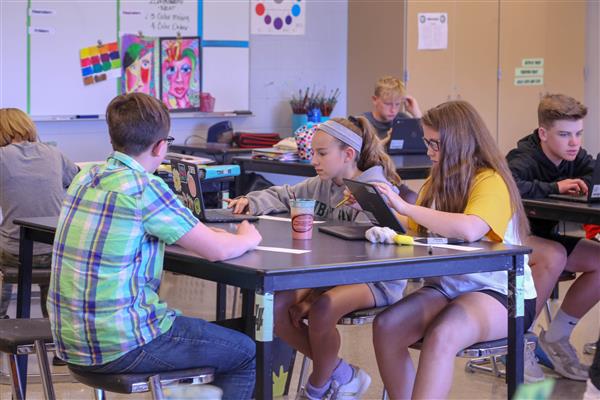Learning Connection
Page Navigation
Planning for high school should start in middle school

When Lila Entwistle was in middle school she knew she would want to have the opportunity in high school to take classes at CAPS or participate in Career Ready Programs.
During her freshman year at Blue Valley High School, Entwistle, 16, took biology.
Entwistle took anatomy her sophomore year, setting her up to now pursue her associate's degree of science through Blue Valley’s dual-degree program, an opportunity that wouldn’t have been available if it wasn’t for the early planning she did in middle school.
“I became interested in science my freshman year because I had biology and I noticed I was retaining that information well and I was doing really good on the tests,” Entwistle said. “Then I kept on going deeper down onto that path which is where I am now.”
Planning for high school is one of the most beneficial things middle school students can do to prepare for their last four years of secondary education.
There are opportunities in high school that aren’t as readily available unless certain classes and credits are earned in middle school.
“High school sounds like a long way away when you’re 10 years old but the academic choices you make going into middle school impact your potential choices at the high school level,” said Emily Demo, Blue Valley’s student support services district coordinator.
For example, students looking to enroll in CAPS during their junior or senior year will need to earn enough credits during their freshman and sophomore years to be eligible and work the program into their schedule.
Demo said having the opportunity to enroll in CAPS takes pre-planning going into freshman year and choosing classes and earning grades that put students in a good position to enroll.
Students can also pre-plan for college by taking high school classes that earn them college credit.
Blue Valley’s Career Ready Programs is another great avenue for students interested in determining their passion and future career path.
“I know we aren’t asking kids to make a career choice but if you start to do some career exploration and you decide I would like to be an electrician or I’m interested in cyber security, we have some industrial tech courses that students can start to look into at our high school that can then start to prepare them if they want to do some of our CRP at Johnson County Community College,” said Adam Wessel, Blue Valley’s Director of Career Ready Programs.
“It’s not a pre-requisite or a requirement, it’s just another exploratory option to look at before you do decide to go to JCCC.”
Entwistle will graduate high school with not only a diploma but an associate’s degree. She has already decided to attend the University of Kansas and pursue a career in dermatology.
Students exploring career and academic options in middle school should be taking classes that allow them to learn more about a career field they are interested in.
“I think sometimes in high school we have kids that take classes just because they need it as a grad requirement and they don’t maybe put as much thought into taking something that could potentially be meaningful for them after high school,” Wessel said.
Creating a four-year plan for high school is an important step in middle school but it shouldn’t be set in stone.
“It shouldn’t be a year-by-year plan,” said Kelly Ott, Blue Valley’s Executive Director of Curriculum, Instruction and Innovation. “It should be a four-year plan that’s amended each year.”
Students should also take advantage of opportunities such as family nights where information is shared about specific programs.
“Good planning, lots of exploration and taking advantage of information opportunities equals more flexibility, more options and greater satisfaction in high school,” Ott said. “I think it’s about being more purposeful in middle school and taking an active approach instead of letting school happen to you.”
Middle school is also a great time to work on academic and executive functioning skills in a lower-stakes environment, Demo said. Students can build a foundation for turning in homework on time, working on timelines and learning how to ask for help and support from school staff members.
Entwistle said middle school students should spend the time figuring out subjects they are best at and pursue classes in high school that fall within those fields.
“When you’re first enrolling for classes, start with a blank slate,” Entwistle said. “You can first start out by doing something you really enjoy then the next year narrow in on that. Then the next two years keep figuring out what you want to do and dial in on that specifically.”

